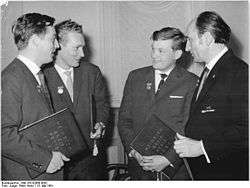Heinrich Greif Prize
The Heinrich Greif Prize (German: Heinrich-Greif-Preis) was an East German state award bestowed on individuals for contribution to the state's cinema and television industry.
| Heinrich Greif Prize | |
|---|---|
| Awarded for | "outstanding achievements in Socialist-Realist cinema and television" |
| Country | German Democratic Republic |
| Presented by | Ministry of Culture of the Democratic Republic of Germany |
| First awarded | 1951 |
| Currently held by | defunct; last awarded in 1989 |

History
The prize was awarded by the East German Ministry of Culture for "outstanding achievements in Socialist-Realist cinema and television"[1] and was presented annually to directors, cinematographers, writers and other filmmakers who were recognized for creating valued works in the field. It had three classes, and originally could be bestowed only in collective, to a group of producers. Since 1959, awards for single persons were also granted.[2] The recipients were given a silver medal, a diploma and a sum of money, which varied from 7,500 East German Mark to 20,000. Since 1973, the medals were no longer made of silver.[3]
Established at 17 May 1951 in memory of actor Heinrich Greif, it was first awarded on 25 May that year.[4] The 1st class was received by the creators of The Eyewitness newsreel series, the 2nd Class by the production team of the documentary The Way Upwards and the 3rd was given to the makers of a series of popular science films.[5]
The prize's presentation ceremony mostly took place on 11 March, Greif's birthday.[6] It was awarded for the last time in 1989.[7]
Notable recipients
- Ulrich Plenzdorf (awarded 1971)
- Frank Beyer (1961, 1984)
- Heiner Carow (1959, 1967)
- Heinz Kahlau (1962)
- Herbert Köfer (1964)
- Manfred Krug (1962)
- Kurt Jung-Alsen (1973)
- Vasily Livanov (1969)
- Günter Reisch (1978)
- Günther Rücker (1966)
- Helga Schubert (1983)
- Günther Simon (1955)
- Lothar Warneke (1971, 1983)
- Job von Witzleben (1966)
References
- Frank Bartel, Jürgen Karpinski. Auszeichnungen der Deutschen Demokratischen Republik von den Anfängen bis zur Gegenwart. ASIN B003DK9T42. Pages 110-111.
- Magdalena Heider, Kerstin Thöns. SED und Intellektuelle in der DDR der fünfziger Jahre. ISBN 978-3-8046-8758-5. Page 58.
- Günter Tautz. Orden, Preise und Medaillen: staatliche Auszeichnungen der Deutschen Demokratischen Republik. OCLC 8729042. Page 151.
- Bundesministerium für Gesamtdeutsche Fragen. Die SBZ von A bis Z: Ein Taschen- und Nachschlagewerk übre die Sowjetische Besatzungszone Deutschlands. ASIN B001TL50K4. Pages 196-197.
- DEFA chronicle of 1951.
- Historisches Museum Dresden. Orden und Ehrenzeichen der Deutschen Demokratischen Republik. OCLC 8398468. Page 20.
- Klaus Finke. Politik und Mythos: Kader, Arbeiter und Aktivisten im DEFA-Film. ISBN 978-3-8142-0821-3. Page 133.
External links
- A photo of the Heinrich Greif Prize's medal, in a list of East German prizes.
- DEFA's annual chronicle 1945-1989, with all the prize winners listed.